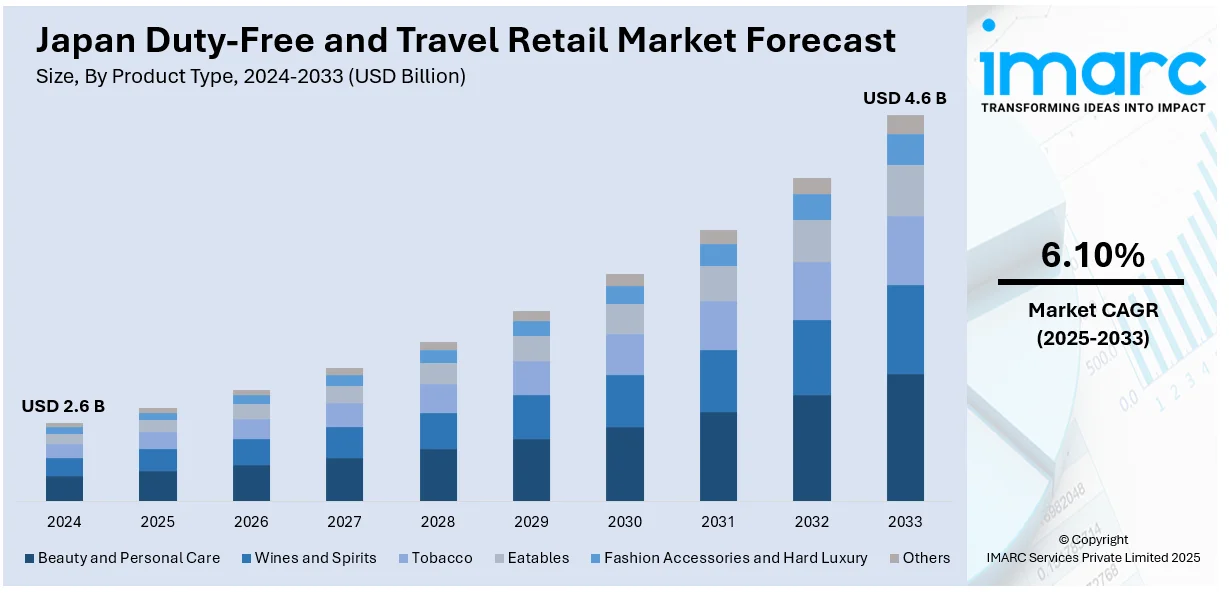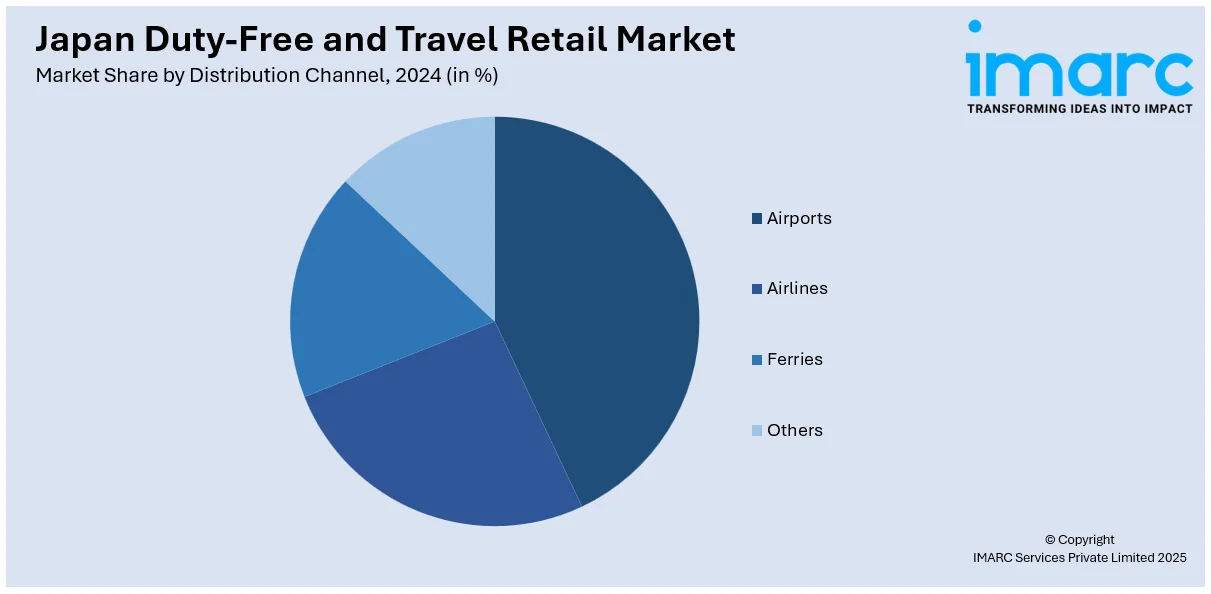
Japan Duty-Free and Travel Retail Market Size, Share, Trends and Forecast by Product Type, Distribution Channel, and Region, 2025-2033
Japan Duty-Free and Travel Retail Market Overview:
The Japan duty-free and travel retail market size reached USD 2.6 Billion in 2024. Looking forward, IMARC Group expects the market to reach USD 4.6 Billion by 2033, exhibiting a growth rate (CAGR) of 6.10% during 2025-2033. Increasing international tourism, rising disposable incomes, expanding airport retail spaces, attractive product offerings, growing demand for luxury goods, favorable exchange rates, and Japan's reputation as a global shopping destination are some of the factors propelling the growth of the market.
|
Report Attribute
|
Key Statistics
|
|---|---|
|
Base Year
|
2024 |
|
Forecast Years
|
2025-2033
|
|
Historical Years
|
2019-2024
|
| Market Size in 2024 | USD 2.6 Billion |
| Market Forecast in 2033 | USD 4.6 Billion |
| Market Growth Rate 2025-2033 | 6.10% |
Japan Duty-Free and Travel Retail Market Trends:
Innovation in Duty-Free Product Launches
In Japan duty-free and travel retail market, the introduction of advanced, eco-friendly product designs is gaining momentum. A notable shift towards innovative tobacco alternatives is evident as new offerings, featuring cutting-edge induction heating technology and bladeless features, are showcased at prominent retail hubs like major airports. These products, emphasizing sustainability, align with growing consumer interest in environmentally conscious options while traveling. This reflects a broader movement towards enhanced functionality, sleek design, and modern technology in the products available in duty-free locations. With innovations like these, travelers can expect a more diverse, eco-friendly selection of alternatives, reinforcing the shift toward sustainable travel retail experiences in Japan’s dynamic market. For example, in March 2024, Philip Morris International introduced its IQOS Iluma I line at major Japanese duty-free locations, including the Narita and Kansai airports. This launch marked the 10th anniversary of IQOS and featured innovations such as eco-friendly designs and bladeless induction technology.

Growth of Wellness Brands in Duty-Free Retail
Japanese wellness and skincare brands are increasingly making their mark in the duty-free and travel retail space. A notable shift is the rise of holistic beauty concepts, integrating skin and mind wellness, which cater to a growing global demand for well-being-focused products. With the launch of exclusive counters in key locations like department stores, these brands offer premium, locally crafted skincare solutions that emphasize natural ingredients and mindful luxury. This movement reflects the expanding influence of Japanese culture and beauty philosophies, particularly in bustling, high-end retail environments. The integration of wellness into travel retail highlights a broader shift towards offering travelers not only beauty products but also a sense of tranquility and self-care, aligning with their evolving preferences for health-conscious and sustainable choices while exploring new destinations. For instance, in February 2023, Shiseido Travel Retail introduced the Japanese skin and mind brand, Baum, to travel retail by opening its first counter with Japan Duty-Free Ginza at Mitsukoshi Ginza Department Store in downtown Tokyo.
Japan Duty-Free and Travel Retail Market Segmentation:
IMARC Group provides an analysis of the key trends in each segment of the market, along with forecasts at the region/country level for 2025-2033. Our report has categorized the market based on product type and distribution channel.
Product Type Insights:
- Beauty and Personal Care
- Wines and Spirits
- Tobacco
- Eatables
- Fashion Accessories and Hard Luxury
- Others
The report has provided a detailed breakup and analysis of the market based on the product type. This includes beauty and personal care, wines and spirits, tobacco, eatables, fashion accessories and hard luxury, and others.
Distribution Channel Insights:

- Airports
- Airlines
- Ferries
- Others
A detailed breakup and analysis of the market based on the distribution channel have also been provided in the report. This includes airports, airlines, ferries, and others.
Regional Insights:
- Kanto Region
- Kansai/Kinki Region
- Central/Chubu Region
- Kyushu-Okinawa Region
- Tohoku Region
- Chugoku Region
- Hokkaido Region
- Shikoku Region
The report has also provided a comprehensive analysis of all the major regional markets, which include the Kanto region, Kansai/Kinki region, Central/Chubu region, Kyushu-Okinawa region, Tohoku region, Chugoku region, Hokkaido region, and Shikoku region.
Competitive Landscape:
The market research report has also provided a comprehensive analysis of the competitive landscape. Competitive analysis such as market structure, key player positioning, top winning strategies, competitive dashboard, and company evaluation quadrant has been covered in the report. Also, detailed profiles of all major companies have been provided.
Japan Duty-Free and Travel Retail Market News:
- In September 2024, Shiseido launched its inaugural travel retail campaign, "From Shiseido With Love," in Japan. The campaign featured the Sense of Place collection, showcasing city-themed packaging, exclusive skincare sets, and culturally immersive shopping experiences, aligning with Japan’s rich cultural heritage.
- In September 2024, Rituals Cosmetics, in collaboration with the Bluebell Group, opened its first flagship store in Tokyo's Aoyama district. The store combines Dutch craftsmanship with Japanese design, offering premium well-being products and enhancing the brand's presence in Japan.
Japan Duty-Free and Travel Retail Market Report Coverage:
| Report Features | Details |
|---|---|
| Base Year of the Analysis | 2024 |
| Historical Period | 2019-2024 |
| Forecast Period | 2025-2033 |
| Units | Billion USD |
| Scope of the Report |
Exploration of Historical Trends and Market Outlook, Industry Catalysts and Challenges, Segment-Wise Historical and Future Market Assessment:
|
| Product Types Covered | Beauty and Personal Care, Wines and Spirits, Tobacco, Eatables, Fashion Accessories and Hard Luxury, Others |
| Distribution Channels Covered | Airports, Airlines, Ferries, Others |
| Regions Covered | Kanto Region, Kansai/Kinki Region, Central/Chubu Region, Kyushu-Okinawa Region, Tohoku Region, Chugoku Region, Hokkaido Region, Shikoku Region |
| Customization Scope | 10% Free Customization |
| Post-Sale Analyst Support | 10-12 Weeks |
| Delivery Format | PDF and Excel through Email (We can also provide the editable version of the report in PPT/Word format on special request) |
Key Questions Answered in This Report:
- How has the Japan duty-free and travel retail market performed so far and how will it perform in the coming years?
- What is the breakup of the Japan duty-free and travel retail market on the basis of product type?
- What is the breakup of the Japan duty-free and travel retail market on the basis of distribution channel?
- What are the various stages in the value chain of the Japan duty-free and travel retail market?
- What are the key driving factors and challenges in the Japan duty-free and travel retail market?
- What is the structure of the Japan duty-free and travel retail market and who are the key players?
- What is the degree of competition in the Japan duty-free and travel retail market?
Key Benefits for Stakeholders:
- IMARC’s industry report offers a comprehensive quantitative analysis of various market segments, historical and current market trends, market forecasts, and dynamics of the Japan duty-free and travel retail market from 2019-2033.
- The research report provides the latest information on the market drivers, challenges, and opportunities in the Japan duty-free and travel retail market.
- Porter's five forces analysis assist stakeholders in assessing the impact of new entrants, competitive rivalry, supplier power, buyer power, and the threat of substitution. It helps stakeholders to analyze the level of competition within the Japan duty-free and travel retail industry and its attractiveness.
- Competitive landscape allows stakeholders to understand their competitive environment and provides an insight into the current positions of key players in the market.
Need more help?
- Speak to our experienced analysts for insights on the current market scenarios.
- Include additional segments and countries to customize the report as per your requirement.
- Gain an unparalleled competitive advantage in your domain by understanding how to utilize the report and positively impacting your operations and revenue.
- For further assistance, please connect with our analysts.
 Request Customization
Request Customization
 Speak to an Analyst
Speak to an Analyst
 Request Brochure
Request Brochure
 Inquire Before Buying
Inquire Before Buying




.webp)




.webp)












